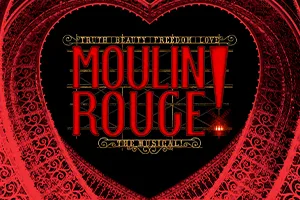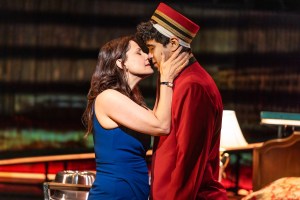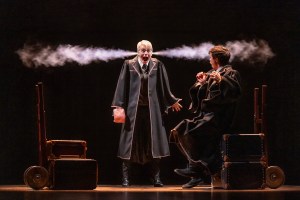Moulin Rouge! The Musical Versus Moulin Rouge! the Movie: A Closer Look
We break down what has changed from Baz Luhrmann’s 2001 film to the new Broadway musical directed by Alex Timbers.
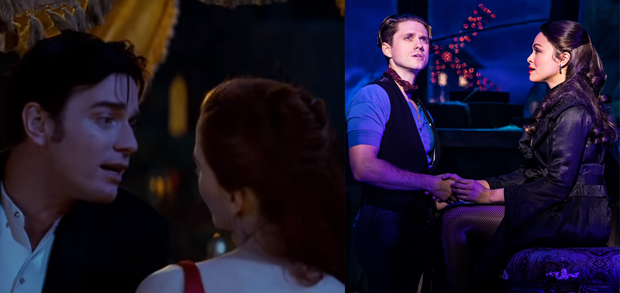
(© Twentieth Century Fox / Matthew Murphy)
When Moulin Rouge! was released in theaters in 2001, many considered it a potential opening salvo in the resurrection of the live-action movie musical — a genre that had been mostly moribund since the 1960s. The Academy Award-winning success of Rob Marshall's film adaptation of Chicago the following year further boosted that impression. The promised movie-musical renaissance hasn't fully materialized since then (or, if it has, it has mostly manifested, unexpectedly, in television). Even so, Moulin Rouge! remains popular for director Baz Luhrmann's unabashed extravagance and swooning romanticism, as well as his audacious conceit of using anachronistic pop songs — ranging from Rodgers & Hammerstein to Madonna — to underscore the doomed love story of aspiring bohemian Christian (Ewan McGregor) and courtesan Satine (Nicole Kidman).
Now it has been adapted into a Broadway musical, with Aaron Tveit and Karen Olivo playing those roles. Unlike Luhrmann's film, Moulin Rouge! The Musical isn't so much a possible beacon of new trends as it is a furthering, or even an apotheosis, of ongoing ones: principally, the jukebox musical (such as Ain't Too Proud — The Life and Times of the Temptations and Beautiful: The Carole King Musical) and the screen-to-stage adaptation (such as Beetlejuice and Tootsie). But that's not the only thing that distinguishes the musical from its cinematic source material.
Here are six ways in which Moulin Rouge! The Musical takes the raw materials of the movie and tries to stake out its own identity onstage.
1. Not every song featured in the film made it into the musical (though plenty of new ones have taken their place).

(© Twentieth Century Fox / Matthew Murphy)
If anything, Moulin Rouge! The Musical is even more about the featured pop songs than the movie was, with tunes from Lady Gaga, OutKast, and tons more shoehorned into the show. Not every song Luhrmann used in the film made it to Broadway, though. Noticeably absent are three songs: Nirvana's "Smells Like Teen Spirit," which underscored a lavish song-and-dance number inside the Moulin Rouge early on in the film; Madonna's "Like a Virgin," underscoring an attempt by Moulin Rouge owner Harold Zidler (Jim Broadbent) and others to keep the Duke of Monroth (Richard Roxburgh) away from Satine; and Queen's "The Show Must Go On," sung by Zidler during a montage leading up to the "Spectacular Spectacular" climax. Instead, you get to hear the musical's Satine sing Katy Perry's "Firework" and Zidler (Danny Burstein onstage) belt Sia's "Chandelier", among other aural spectacles bound to make audiences chuckle in recognition.
2. Satine has more agency in the Broadway show than she did in the movie.
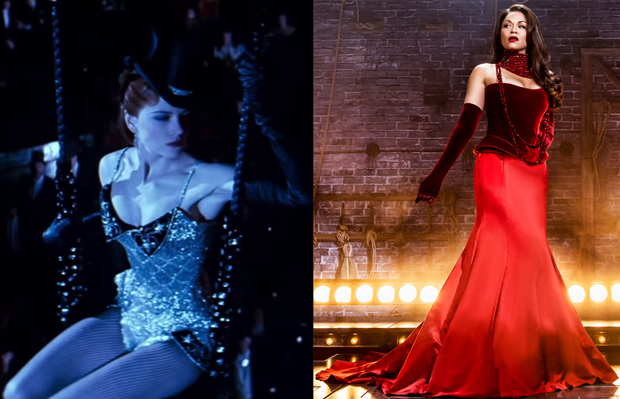
(© Twentieth Century Fox / Matthew Murphy)
To some degree, Luhrmann's film is about a prostitute who, through the love of an innocent bohemian artist, comes to imagine a life outside the Moulin Rouge and, by extension, the societal box in which she exists. The Satine of the stage musical, however, comes off as a much more empowered figure. Already perfectly satisfied with her life at the legendary Parisian nightclub, she doesn't even have aspirations to be the "next Sarah Bernhardt" that Luhrmann's Satine does. This tweak is more in line with progressive mores that no longer dictate that sex work is inherently demeaning. Instead of trying to delay the act of sleeping with the Duke of Monroth, Christian's rival for Satine's affections, she beds him without much hesitation, however unenthusiastically, in order to sustain his interest in the Moulin Rouge.
3. The Duke of Monroth is given more dimension in the Broadway musical.

(© Twentieth Century Fox / Matthew Murphy)
As written by Luhrmann and co-screenwriter Craig Pearce, and played by Roxburgh in the film, the Duke of Monroth, to whom Zidler has promised Satine in exchange for his financial backing, is a sniveling ninny who, in his privileged societal position, has no truck with Christian's bohemian mantra of "truth, beauty, freedom, and love." The characterization of the Duke in John Logan's book, however, is more nuanced; Tam Mutu, who plays the Duke onstage, makes him a charismatic spokesperson for compromising artistic ideals in the face of financial realities. One may even find oneself rooting for Satine to end up with the practical-minded Duke instead of the idealistic Christian.
4. A rival performer at the Moulin Rouge doesn't betray Satine.
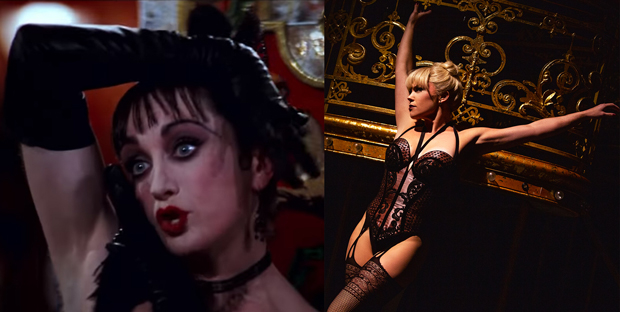
(© Twentieth Century Fox / Matthew Murphy)
In the film, during a rehearsal scene for the planned "Spectacular Spectacular" at the Moulin Rouge, the jealous dancer Nini (Caroline O'Connor) whispers a comment into the Duke of Monroth's ear that tips him off to the affair Satine is having with Christian. Nini still appears in the musical (played onstage by Robyn Hurder), but instead of betraying Satine, she puts her envy aside to warn her about the Duke's controlling tendencies. The sense of sisterhood, even if it's just professional in nature, furthers the stage show's attempts to update the material for a more feminist age.
5. The "Spectacular Spectacular" is no longer a lavish Bollywood-style blowout.
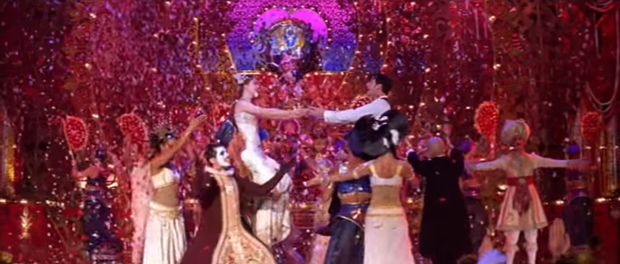
(© Twentieth Century Fox)
Speaking of trying to accommodate 2019 concerns, it was inevitable that the climactic "Spectacular Spectacular" (though never identified by that name onstage) of the musical wouldn't be a straight replication of that of the film. Set in India and concerning a plot-mirroring love triangle between a princess, a bohemian artist, and a maharajah, it's a spectacle built on a foundation of cultural appropriation. It has been replaced onstage by a more generic show-within-the-show. Its connection to the broader storyline, however, remains intact.
6. The film's hyperactive editing style is absent from Moulin Rouge! The Musical.
The most significant difference between the film and the stage show lies in the change of medium. Baz Luhrmann's penchant for maximalism in his direction of Moulin Rouge! manifests itself most noticeably in its frenetic editing style, even in dance sequences, where it might have benefited from Luhrmann backing off to allow viewers to appreciate the design and choreography. This approach is by no means everyone's cup of tea, and many over the years have been as turned off by the film's aggressive in-your-face desire to entertain as enchanted by it. Thankfully, by virtue of its artistic habitat, Moulin Rouge! The Musical is less bound to induce a headache — which is not to say that its director, Alex Timbers, doesn't find other ways to translate Luhrmann's operatic hyper-romanticism to the stage. Derek McLane's wondrous set design, in particular, invites us to bask in this world of idealized desires, dashed illusions, and feverish excess the moment we walk into the Al Hirschfeld Theatre.


